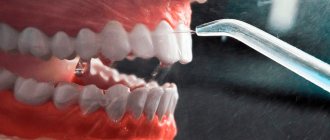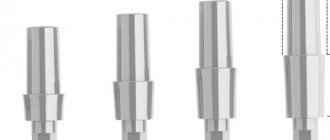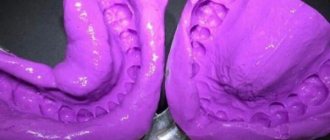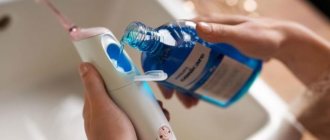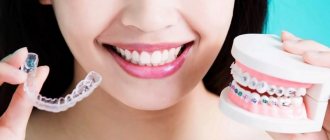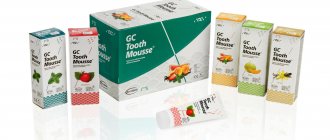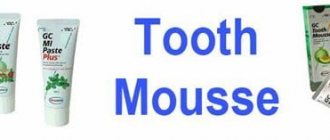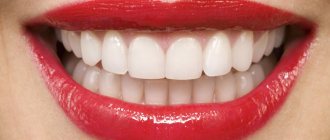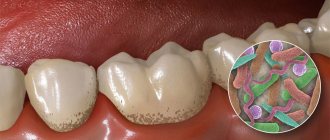The reason for writing this article was a story that recently aired on the NTV channel in the “Miracle of Technology” program. In a detailed story, the author tried to answer the question - can an oral irrigator become a real “home dentist” and get rid of 99.9% of dental plaque, as the advertisement claims? After testing, the authors summarize: “it’s hardly worth expecting a miracle from the irrigator,” especially since “British scientists” also confirm this. It is better to use a toothbrush correctly, journalists conclude. And we will draw our conclusions. The authors of the story clearly did not read our blog. Otherwise, they would know that the irrigator cannot be the one and only device that is capable of destroying 99.9% of all bacteria in the oral cavity. Just like a toothbrush. We have always paid attention to the fact that it is necessary to use this device after brushing with a toothbrush. And only in this case can you achieve the desired result. But the authors of the story heard only the loud slogans of unscrupulous sellers, in which they insist that the irrigator is a miracle of miracles, and it is capable of single-handedly coping not only with plaque, but also with tartar.
Since such advertising messages continue to be heard, and journalists are trying to refute them just as loudly, we will have to once again talk about the effectiveness of irrigators. Talk calmly, without using cliches and categoricalness inherent in some journalists.
Irrigator - a device for cleaning teeth and gums
First, let's figure out what this personal hygiene item is. The irrigator resembles an electric toothbrush with a thin tip instead of bristles. This device operates on the principle of a hydraulic compressor. Pressure is created inside the device, pushing water through the tip under high pressure. The flow of liquid washes away plaque and food particles from the teeth, cheeks, gums and tongue, thereby preventing the development of numerous dental diseases. Some experts do not recommend using the device for patients with problem gums, fearing that it may worsen the situation. However, modern devices, as a rule, have a built-in massage mode that strengthens soft tissues and improves their condition. However, people with acute inflammation should not use the device for some time.
The unique, multifunctional device JETPIK JP200 Elite combines an electric sonic toothbrush, irrigator and dental floss. The components and the device itself are stored in a convenient plastic container, which is ideal for traveling or storing in a small bathroom.
TOP 10 irrigators based on the results of 2020
10th place. Waterpik WF-02 Cordless Express
The TOP 10 irrigators opens with the Waterpik WF-02 Cordless Express model. This is a portable oral device that is convenient to take with you on the go. The model supports 2 operating modes, the volume of the built-in reservoir is 150 milliliters.
Advantages:
- Compact dimensions: the smallest option among analogues;
- Excellent performance: fluid pressure 310-520 kPa, pulse frequency 1,200/min;
- Battery life: charge lasts about 7 days;
- Spray duration: 30 seconds.
Flaws:
- Small tank;
- Limited number of attachments: only 2 pieces;
- In terms of power it is noticeably inferior to other products.
9th place. Waterpik WP-70 E2 Classic
Stationary family irrigator. The volume of the reservoir is 1,000 ml, the liquid pressure varies between 70-620 kPa. The device operates on network power and is designed for two users.
Advantages:
- Multifunctionality: 5 operating modes and 4 interchangeable nozzles;
- High performance: ideal for caring for dental structures;
- Adjustable power: you can choose the optimal mode for teeth and gums;
- The optimum ratio of price and quality.
Flaws:
- Quite noisy;
- The cord is only 130 centimeters long, so you have to use extension cords.
8th place. Waterpik WP-108 E2 Ultra Gold
The stationary device comes in an unusual gold case. Provides a pulsation frequency of 1,400 pulses per minute, operates in 10 modes. The set includes 7 replaceable nozzles.
Advantages:
- It works very quietly for its size;
- Comfortable in using;
- Equipped with a large number of replaceable attachments.
Flaws:
- Short power cord: 1.3 meters;
- No fixation to the wall
7th place. Waterpik WP-300 E2 Traveler
Stationary model designed for 1 user. The device creates 1,400 pulsations per minute, the noise level does not exceed 71 dB. The irrigator operates in 3 modes and comes with 4 replaceable nozzles.
Advantages:
- Convenient location of the power key: on the handle;
- Compact dimensions;
- Good set;
- The set includes a bag-case for carrying and storage;
Flaws:
- Small reservoir: only 450 ml;
- Limited number of operating modes;
- Insufficient power cord length.
6th place. Waterpik WP-450 E2 Cordless Plus
Irrigator with 210 ml tank. The battery charge lasts about 7 days, the device operates in two modes, and is equipped with 4 replaceable attachments. Nominal water pressure – 520 kPa, pulsation frequency: 1,450 per minute. This provides complete care for the oral cavity and dental prostheses.
Advantages:
- Ideal for use on the go;
- The set includes a case for transportation and safe storage;
- Resource-intensive battery;
- Relatively good power.
Flaws:
- There is no power key lock;
- Small reservoir for liquid.
5th place. Waterpik WP-112 E2 Ultra Black
One of the best stationary models in its price segment. Available in a black plastic case, the power button is located on the handle. The irrigator is designed for 2 users and operates in 10 modes. The delivery set includes 7 replacement nozzles.
Advantages:
- Adjustable water pressure: operating range 70-690 kPa;
- Compact dimensions;
- Low noise level.
Flaws:
- Short cord for connecting to the network;
- Suitable for home use only.
4th place. Waterpik WP-260 E2 For kids
Children's stationary irrigator intended for home use. The device is designed for 1 person, is equipped with a 450 ml tank, and operates from the mains. The set includes 2 replaceable nozzles.
Advantages:
- It works very quietly and does not scare children;
- Cleans the interdental space efficiently;
- Provides delicate gum care;
- It features an original design.
Flaws:
- Total 3 operating modes;
- Not suitable for travel;
- Small tank volume.
3rd place. Waterpik WP-100 E2 Ultra
Multifunctional irrigator designed for two people. The device operates from the mains and creates 1,400 pulsations per minute. The rated pressure power is 690 kPa, the delivery set includes 7 replaceable nozzles. For oral care, 10 operating modes are offered.
Advantages:
- Highly effective in preventing dental diseases;
- Fine adjustment of liquid pressure;
- Modern design;
- Easy control and setup;
- Power button on the handle.
Flaws:
- Short power cord.
2nd place. Waterpik WP-660 E2 Ultra Professional
The model took an honorable second place in the rating, but it is the best stationary irrigator, according to experts and users. The professional model provides complete care for the oral cavity and dental implants.
Advantages:
- Low noise: 65dB;
- 7 replaceable nozzles and fine adjustment of water pressure;
- Easy control and setup;
- Effective in the treatment of oral diseases.
1 place. Waterpik WP-560 EU Cordless Advanced
The first place in our ranking of the best irrigators is occupied by the portable model of the Waterpik WP-560 Cordless Advanced series. Although the model went on sale only at the very end of 2021, it has already managed to win the hearts of buyers.
The irrigator is manufactured in accordance with the requirements of the time and taking into account all the shortcomings of previous models.
Advantages:
- Ultra quiet motor (the quietest model on the market)
- Waterproof case without connectors (magnetic charging);
- LED indicators of charge and operating modes;
- Fast charging - full charge in 4 hours;
- 3 water pressure modes and 4 handles included.
The rating of the best irrigators has come to an end, we hope that this will help you choose the right option. Please note that the review of irrigators was made based on the results of 2021. The line of oral care devices is constantly updated, so in 2022 we will prepare for you a new review of the best irrigators.
Why do you need an irrigator?
Why do you need an oral irrigator? Firstly, it copes with tasks that many toothbrushes cannot do: it removes plaque not only from the surface of the teeth, but also from hard-to-reach places: interdental spaces, as well as areas between the tooth and the gum. The accumulation of deposits in these areas that are impenetrable to brushing leads to such common diseases as cervical caries, diseases of the periodontal tissues - gingivitis and periodontitis, as well as caries of contact surfaces. Secondly, an irrigator is necessary for owners of braces, dentures, crowns, veneers, lumineers and implants. Such orthopedic or orthodontic structures make oral hygiene difficult and require special care. And finally, thirdly, the stream of water coming out of the irrigator cleans out periodontal pockets and also massages the gums, which helps strengthen them and, as a result, reduce bleeding.
Bacterial plaque
In this conversation we cannot do without once again briefly considering the mechanism of bacterial plaque formation. The oral cavity is an ideal place for bacteria - constant temperature, humidity, and most importantly - there is always food. Bacteria have chosen the surface of teeth for their carefree life. They attach to the enamel, form numerous colonies and wait for their main delicacy - carbohydrates - to arrive. Bacteria love sweets. When processing carbohydrates, bacteria release various acids. The most dangerous is lactic acid, which can destroy the enamel structure. Microcracks form through which cariogenic microbes enter the tooth tissue, damaging dentin.
Microbes have adapted to protect themselves as much as possible. As soon as colonies form on the surface of the tooth, a surface film immediately begins to form, protecting them from external factors. The film thickens over time. Moreover, the film formation process is very fast. Within four hours after bacteria colonize the tooth surface, this film covers the tooth. After 12 hours, it forms a fairly dense structure, which requires effort to destroy.
Varieties
Today there are a large number of irrigators, differing from each other in various parameters. Devices are divided into portable and stationary, powerful and not very powerful, with one or more nozzles and modes, with and without microbubble technology, with a water tank and with a connection to a tap, as well as with built-in dental floss, like JETPIK irrigators, in several times increasing the effectiveness of teeth cleaning. Do not also forget that each device has a certain warranty period, depending on the policy of the manufacturer. Read about how to choose the best irrigator in our other articles.
Reliable and convenient irrigator for the whole family Hydro Floss Kitty Waterjet
Kinds
Stationary
The power of the supplied jet usually does not exceed 550 kPa. The most preferred pulsation frequency does not exceed 1200 pulsating emissions. The device is mounted on a wall or any horizontal surface.
Portable
Completely autonomous, battery-powered devices with a jet power of at least 520 kPa. As a rule, they have the possibility of stepwise adjustment of modes.
Flow irrigators
A fairly democratic and simple device that changes power using a mixer valve.
Mechanical irrigators
The intensity of the supplied jet is set by pumping up the pump by hand.
How to use an irrigator correctly
At first, it is recommended to set the device to the weakest setting so as not to damage soft tissues and cause pain. During cleaning, the handle of the device should be held at an angle of 90° to the surface of the teeth. You should tilt your head so that the liquid will immediately flow into the sink. How often you need to use an oral irrigator, the number of daily procedures and their duration depend on the individual characteristics of the owner of the device. For some, it will be enough to use the irrigator no more than 3 - 4 times a week for 5 minutes daily, while for others, for example, those who wear braces, crowns, implants or other structures or suffer from crowded teeth, to achieve the desired result, you should wash your teeth at least twice a day for 10-15 minutes. In any case, the plan for using the irrigator must be approved by a specialist.
By the way, some devices have a sensor installed that helps to organize the cleaning process correctly. Based on the time given to him, he independently plans the course of the procedure and “informs” his owner when he needs to move from the treated area of the oral cavity to the untouched one.
The Panasonic Dentacare Handy EW 1211 portable irrigator is one of the best devices in terms of reliability.
Causes of tartar formation
- Irregular or improper brushing of teeth.
- Predominance of soft foods in the diet.
- Chewing predominantly on one side of the jaw (left or right).
- Using low-quality toothbrushes and toothpastes.
- Metabolic disorders, primarily mineral and salt.
- Incorrect position of teeth.
- Rough surface of teeth due to poorly placed fillings.
- The presence of orthodontic and orthopedic structures in the mouth.
How often should you use a waterpik?
Experts differ in answer to this simple question. The only thing that dentists are unanimous about is that it all depends on the condition of the oral cavity and for what purpose you are going to use the irrigator - preventatively or as part of complex therapy.
For healthy teeth
If you take care of your teeth and do not neglect daily personal hygiene, then it is enough to use the irrigator once a day for 4 days a week - solely for the purpose of preventing the formation of tartar in hard-to-reach places.
For people with bad habits
For heavy smokers, as well as those who like to abuse black coffee, tea or red wine, who are prone to the formation of dense plaque, dentists recommend using an irrigator 2 times a day every day as the final stage of oral hygiene.
During pregnancy
Women expecting a baby are extremely susceptible to any infection. Therefore, to prevent the activation of bacteria that cause caries, an irrigator is indispensable at least once a day.
For gum diseases
If you have chronic inflammatory gum diseases, such as periodontitis or gingivitis, the frequency of use of the irrigator, especially a special periodontal attachment, should be regulated by the periodontist who is observing you.
When wearing braces
Modern brace systems, despite their dramatic progress compared to the designs of 20 years ago, require increased hygiene. In this situation, it is advisable to use an irrigator after each meal during the day.
If you have dentures
The situation is similar with any removable dental prostheses: the more often and thoroughly their hygiene is carried out using an irrigator, the better and longer they will last.
Attention!
After undergoing surgical interventions in the oral cavity, the use of an irrigator should be abandoned until the time when the attending physician allows it.
What does the presence of tartar lead to?
Plaque or dental plaque, formed with the help of microorganisms from untimely removed food debris, while on the tooth, gradually “petrifies”, adsorbing on its surface mineral substances found in saliva. Hence the typical places of greatest formation of tartar near the ducts of the large salivary glands. Subsequently, increasing in volume, tartar, irritating and ischemic (squeezing, disrupting blood circulation) of the gum, causes its inflammation with its subsequent subsidence. Behind the gum, the bone disappears (dissolves), which is covered by this gum, holding the roots of the teeth. As a result, with large losses of bone tissue, tooth mobility appears, which increases like an avalanche, since, even with the appearance of slight mobility, an additional mechanism of dissolution of the bone that holds the roots of the teeth is triggered. It consists of the following: moving (staggering), the teeth break (injure) the edges of the bone tissue that holds them, as a result of which the bone dissolves, exposing another small area of the root and causing even greater mobility, which, in turn, causes greater injury and care bones, which further enhances mobility. A vicious circle develops where tooth mobility leads to injury and bone resorption, and bone resorption leads to mobility. This, in turn, leads to spontaneous loss of, alas, no longer baby teeth. Once tooth mobility appears, it progresses relatively slowly, but upon reaching a certain threshold value, it increases at such a rate that patients often lose all their teeth within 1-2 years. No one can stop this process - neither the doctor nor the patient.
Rules for caring for the device
The irrigator, like all electrical appliances, requires special care. The device should be washed as follows: firstly, do not under any circumstances immerse the entire irrigator in water, especially when it is turned on - it may short out (which is deadly!), and its parts may rust. Secondly, do not use unboiled water to clean the device, only filtered and, preferably, warm water. Otherwise, scale will form inside the mechanism, which will lead to its breakdown. In order to thoroughly clean the irrigator, you need to fill it exactly halfway with warm water, empty the reservoir after a couple of minutes, rinse the device and nozzles for the irrigator, and then wipe all components dry. Particularly advanced manufacturers produce devices together with a UV sanitizer designed to disinfect replaceable attachments. The ultraviolet radiation on which it works destroys microbes accumulated on the tips and thus prevents the development of dental diseases. As for the storage conditions of the irrigator, it should be kept in a dry place. Touching the appliance plug with wet hands is strictly prohibited.
In principle, the irrigator should not be cleaned too often, except for those cases when you pour special decoctions into its tank. Particles of herbs from the infusion remain inside the device and may damage its operation.
Multifunctional irrigator OR 820M Donfeel with nasal attachment
How to choose a liquid for an irrigator?
When using the irrigator, special attention should be paid to the cleaning agent. Usually, irrigators come with a special balm that should be added to the water in the tank. The type of balm and the level of its concentration in water will depend on the condition of the oral cavity and the presence of certain dental problems. Some people pour regular rinse aids into the tank, but they foam quite a lot and make the cleaning process difficult. You can also use ordinary water as a cleaning agent, but only filtered water - it is safer and does not contain impurities that settle inside the device and interfere with its operation. Remember: if there is no water in the container, the irrigator cannot be turned on.
It is important to remember that it is not enough to buy an irrigator and think that it will save you from using conventional hygiene products! The device will provide a final cleaning of your teeth, removing what the toothbrush couldn’t handle. And the supplement will improve blood circulation, stimulate the renewal of soft tissues, prevent the formation of tartar and eliminate bad breath. Our Irrigator Rating 2021 will help you choose the right model.
What is tartar?
Tartar on the lingual side of the lower anterior teeth.
Tartar is, in essence, dental plaque (dental plaque) consisting of food debris, microorganisms and mucus, which is located on the teeth closer to the gingival margin, and sometimes covers the entire visible part of the tooth. Most often, tartar accumulates in places that are difficult for a brush to reach or where its movements are incorrect or insufficient. It forms most quickly on teeth located in close proximity to the ducts of the large salivary glands, as a result of which a large amount of it is found on the inner surface of the lower central teeth (where the duct of the sublingual salivary gland opens), on the outer surface of the upper 6th and 7th teeth ( where the duct of the parotid salivary gland opens), as well as in the interdental spaces and on the back surface (and sometimes on the chewing) of wisdom teeth (in these places it can be difficult to completely remove food debris and plaque when brushing).

